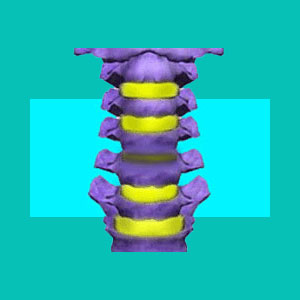
Cervical degenerative disc disease exercises comprise some of the most common of the conservative treatment approaches for DDD in the neck. Cervical degenerative disc disease is absolutely normal, with the majority of adults showing moderate signs of the condition by the age of 30 to 40. The only area known to demonstrate more DDD in most patients is the lumbar spine.
Disc degeneration is theorized to be created by wear and tear, caused by the typical movements of the neck over a lifetime of use. In essence, the structural changes are enacted by movement. Therefore, exercise seems like the least logical choice for a treatment, since all it does is force the patient to mobilize the neck even more, increasing the deterioration of the already desiccated structures. However, exercise does provide relief for many patients, despite this fact.
This treatise takes a close look at how exercise therapy is employed to treat CDDD and provides guidance for patients who are considering using physical therapy as a disc pain management or neck pain rehabilitation system.
Indications for Cervical Disc Disease Exercises
Exercises are most often prescribed when CDDD is the suspected source of pain, but more invasive modalities are not yet deemed appropriate. Typically, doctors will hope that exercise alone may be effective in resolving symptoms, but will often also prescribe pain management drugs to placate patients.
Mild to moderate CDDD is often treated with exercise therapy and physical therapy, while more advanced and extreme forms of the condition may be too painful for this methodology. Additionally, exercise therapy may not be indicated for patients who complain of increased symptoms with particular movements or activities.
It seems that unless doctors are purposefully trying to worsen mild to moderate cases of CDDD to terribly symptomatic levels, there is no logic in prescribing the therapy. However, many patients do respond well, providing some insight as to why exercise therapy might be useful and effectual for many instances of diagnosed cervical disc deterioration.
Cervical Disc Disease Exercise Problems
When discussing exercise treatment for DDD, there are 2 main concerns which always come to mind:
First is the fact that DDD is seldom a symptomatic condition and is almost never the real source of severe or chronic pain or neurological symptoms. Most neck pain syndromes that are blamed on cervical DDD are clearly misdiagnosed and this statement is clearly backed by countless pieces of research evidence.
Second, even if the pain is the result of degenerated disc, how on Earth can exercise resolve the complaint? Exercise will not rebuild the disc structure, nor stop further degeneration. As mentioned above, movement will increase the rate of degeneration, since the constant bending and flexing of the neck is why the location suffers disc disease to begin with.
Exercise is great for relieving many varieties of pain since it increases circulation and metabolic activity locally and systemically. Exercise combats stiffness and provides muscles and skeletal tissue with the exertion that they naturally crave. Exercise also facilitates the manufacture and release of powerful pain relieving chemicals in the body.
These are the primary reasons why exercise therapy works so well for minor cases of neck or back pain that are blamed on CDDD. Basically, disc disease may not even be the source of pain, but the exercise will help to alleviate the true source, whatever it may be, as long as the symptoms are not inherently linked to mechanical or movement-oriented sources.
The efficacy of exercise therapy is one more piece of proof that disc degeneration is usually a harmless and pain-free process that occurs in the spines of every adult human and many types of advanced skeletal animals, as well. Obviously, exercise is relieving some origin of pain, but it certainly is not changing any types of disc degeneration for the better.
Cervical Degenerative Disc Disease Exercises Conclusion
We love exercise and recommend it as a part of a healthy lifestyle. However, prescribing it for cervical degenerative disc disease is unenlightened, at best, and criminally negligent, at worst. Don’t get us wrong, exercises are unlikely to cause any harm. They are just not likely to do any direct good towards relieving true DDD pain either, unless by the power of the magnificent placebo effect.
Exercise is far more effective for treating many other varieties of back pain and neck pain, such as the types that actually exist when coincidental disc deterioration is the mistakenly-embraced diagnostic theory.
We advise that patients should learn the facts and myths of DDD for themselves and then decide if exercise is logical or not from a scientific perspective.
One last thought on cervical degenerative disc disease exercises: If your doctor listens to your arguments about the questionable use of exercise therapy and responds with the notion that “exercise will support the spine and prevent further disc injury”, or something to that effect, it is time to re-evaluate the usefulness of this doctor. Any caregiver who will propagate incorrect and antiquated ideas about exercise therapy is not anyone you need providing recommendations on your treatment plan or life.
Herniated Disc > Cervical Degenerative Disc Disease > Cervical Degenerative Disc Disease Exercises





